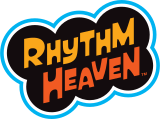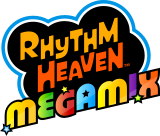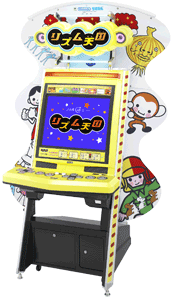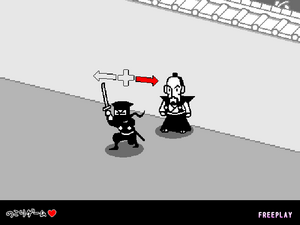Rhythm Tengoku/Arcade
Rhythm Tengoku (リズム天国?, Rhythm Tengoku) is an arcade port of Rhythm Tengoku for the Game Boy Advance. It was developed by Nintendo and published by SEGA. It was released on September 20, 2007 in Japan.
JP Room
| CERO: |
Rhythm Tengoku
Rhythm Heaven
Gameplay
Players start the game with two hearts. Each heart is lost when starting a Rhythm Game. Getting a Superb or Perfect gives an extra heart, as well as close the game for the rest of the Stage. If the player runs out of hearts, they will need to spend a credit to continue (or, depending on the machine's settings, multiple credits, or none if set to Freemode). The player needs to clear all five games and the Remix in the Stage with at least an OK to move on. Depending on the settings, the Remix may be unselectable, requiring the player to clear all the games in order to play it.
Rhythm Games
All of the Rhythm Games from Rhythm Tengoku are available in the 1 Player (1人で遊ぶ?, 1-Ri de Asobu) mode. The arcade version has an Extra stage as well. A selection of games are also present in the 2 Player mode.
1 Player
|
1人で遊ぶ |
|
|
|---|
- Prologue Arcade Karateka.png
|
|
|---|
- Prologue Arcade The Bon Odori.png
|
|
|---|
|
|
|---|
|
|
|---|
When scrolling past STAGE 5, the player receives a notice.
|
|
|---|
|
|
|---|
|
|
|---|
- Prologue Arcade Karateka.png
|
|
|---|
|
|
|---|
- Prologue Arcade Karateka Extra.png
2 Player
|
2人で遊ぶ |
|
|
|---|
- Prologue Arcade Karateka.png
|
|
|---|
- Prologue Arcade The Bon Odori.png
|
|
|---|
|
|
|---|
- Prologue Arcade Karateka.png
|
|
|---|
When scrolling past STAGE 5, the players receives a notice.
|
|
|---|
|
|
|---|
- Prologue Arcade Karateka Extra.png
Differences
- Rhythm-kan Check, Rhythm Shiryo Shitsu, Studio, Café, Toys, Games, Drum Lesson, Staff, and Live are all absent from this version. Most of the music unique from them has been repurposed for new features in this version.
- Neko Machine and Kokuhaku Machine can be seen in the attract mode instead, where they can be interacted with for a limited time.
- The Drum Girls make a cameo on the Player Mode menu.
- If the player enters the game's Service Mode, they can change several settings, including the number of hearts they start off with, how many coins need to be inserted for a credit (Freeplay is also available) and if the Remix is open from the start or not.
- The games Air Batter, Iai Giri, Baikin Hakase, Usagi Tobi, Night Walk and Polyrhythm now have Asobi Kata (あそびかた?, How to Play) animations to make up for the lack of a Practice. Hopping Road also has one in addition to its Practice. All 2P games aside from the ones in Extra have these animations as well, without a Practice. As these are merely animations, and not gameplay, minor differences from the games themselves can be found.
- The player doesn't receive a Try Again for getting a question wrong in the Practice of Quiz Show, the game simply moves on to the next question instead. Failing on the 5th question also gives a Just OK. Due to Perfect being a normal Rank, getting a Superb is impossible.
- Ninja and Ninja no Shison use the Left and Right buttons, instead of ✚ and Ⓐ. The arrows above the player are changed accordingly.
- If the player has played perfectly for the first half of a Rhythm Game, the "Go for a Perfect!" notice will appear on the bottom of the screen. Obtaining it is little different from a Superb, however.
- The game has a leaderboard feature, tallying up the score based on the player's flow at the end of a stage.
- The resolution is larger, and the graphics are manually upscaled to appear smoother. Most non-gameplay graphics are higher quality as well.
Gallery
Regardless of whether or not the player gets a high score, they will always see this screen, with the Girl telling them to try the next stage.
Official Websites
- リズム天国 公式ウェブサイト (Rhythm Tengoku Official Website) [Archive]
Logo
- LogoRhythmTengoku.svg
Trivia
- This is one of the very few games developed by Nintendo and SEGA.
- This was playable in Hyper Japan 2016 in London.
- This is the first game in the series to have a Two Player mode.
- Although, the first multiplayer game in the main series would be Rhythm Heaven Fever.
Unused
- Main article: Rhythm Tengoku/Unused
In Other Languages
| Language | Name | Meaning |
|---|---|---|
| リズム天国 | Rhythm Heaven | |
| Rhythm Tengoku[1] | ||
| Rhythm Tengoku[2] | ||
| Rhythm Tengoku[3] | ||
| Rhythm Tengoku[4] | ||
| Rhythm Tengoku[5] | ||
| Rhythm Tengoku[6] | ||
| Rhythm Tengoku[7] | ||
| Rhythm Tengoku[8] |
References
- ↑ Iwata Asks - Rhythm Heaven - Page 2
- ↑ Iwata Asks | 2. Rhythm Tengoku: The Arcade Game | Iwata Asks: Rhythm Paradise | Nintendo
- ↑ Iwata demande | 2. Rhythm Tengoku : le jeu d’arcade | Iwata demande : Rhythm Paradise | Nintendo
- ↑ Iwata pregunta | 2. Rhythm Tengoku: la recreativa | Iwata pregunta: Rhythm Paradise | Nintendo
- ↑ Iwata fragt | 2. Rhythm Tengoku: Das Arcade-Spiel | Iwata fragt: Rhythm Paradise | Nintendo
- ↑ Iwata Chiede | 2. Rhythm Tengoku: la versione arcade | Iwata Chiede: Rhythm Paradise | Nintendo
- ↑ Iwata vraagt | 2. Rhythm Tengoku: het arcadespel | Iwata vraagt: Rhythm Paradise | Nintendo
- ↑ Iwata Pergunta | 2. Rhythm Tengoku: o jogo arcade | Iwata Pergunta Rhythm Paradise | Nintendo
| Rhythm Tengoku (GBA/Arcade) | ||
|---|---|---|
| Rhythm Games | Omake Corner | |
| STAGE 1 | ||
| STAGE 2 | ||
| STAGE 3 | ||
| STAGE 4 | ||
| STAGE 5 | ||
| Revival | ||
| Technician | ||
| Last Technician | ||
| Arcade Only (1P) | Extra | |
| Arcade Only (2P) | STAGE 1 | |
| STAGE 2 | ||
| STAGE 3 | ||
| STAGE 4 | ||
| STAGE 5 | ||
| Extra | ||
| Rhythm Omocha | ||
| Endless Games | ||
| Miscellaneous | ||
| Rhythm Heaven Series | |||
|---|---|---|---|

|

|

|

|
| 2006, GBA • 2007, Arcade | 2008-2009, DS | 2011-2012, Wii • 2016, Wii U | 2015-2016, 3DS |





























































